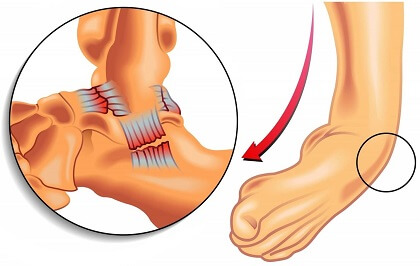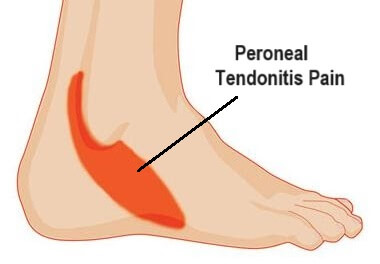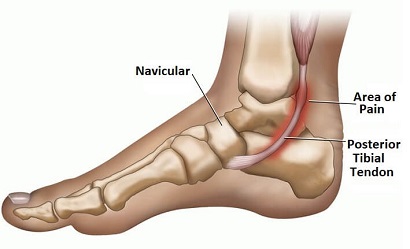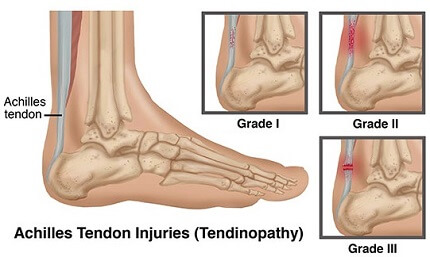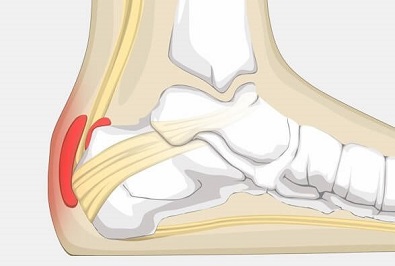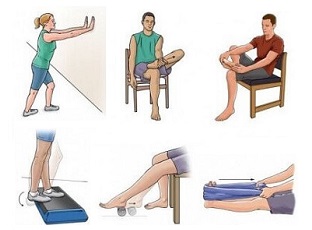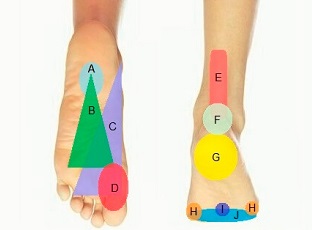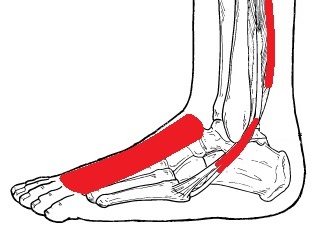- Home
- Foot Pain Symptoms
- Running Foot Pain
Foot & Ankle Pain Running
Written By: Chloe Wilson BSc(Hons) Physiotherapy
Reviewed By: FPE Medical Review Board
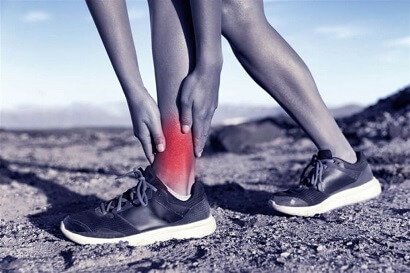
Most runners will complain of foot or ankle pain running at some point, it is an all too familiar problem.
Most runners take around 160-180 steps per minute. Each step sees massive forces transmitting through the foot and ankle and up the leg, with the ankle taking the brunt of the force.
Do this over and over again, and it’s no wonder that foot and ankle pain is such a common, ongoing and frequently recurring problem for runners.
So here we will look at the 10 most common causes of foot and ankle pain from running, how to tell them apart and how to treat them.
Why Do We Get Ankle Pain Running?
Foot and ankle pain from running is usually caused by a combination of:
1. Muscle Imbalance
Weakness and/or tightness in the foot, ankle, calf, knee and hip muscles are a common cause of ankle pain running. Muscle imbalance can make subtle changes to the position of your foot when it hits the ground, which can place certain structures under more stress and lead to foot and ankle pain when running.
2. Overuse
Overuse or over-training is a very common cause of foot and ankle pain running. We’ve all done it. Had a sudden fitness burst, started training for a race, upped our game – for whatever reason.
When we suddenly ask our bodies to work harder than they are used to, particularly over a sustained period of time, rather than gradually working through a training programme, our body sometimes says no. It can’t handle the extra demands on it and we develop ankle pain running, walking, standing or even at rest.
3. Previous Injuries
If you have had a previous foot or ankle injury, you are more likely to suffer from ankle pain running. How many people wait until they’ve fully recovered from an injury before returning to running? The temptation to get back out there is often just too great and people start training too much, too soon, and their body doesn’t have a chance to fully heal.
Maybe it’s just some mild discomfort, maybe the ankle feels a bit weak and wobbly. But they’re fed up of doing the exercises and rehab, and just want to get back running. The niggles continue and we ignore them until one day, it’s too much, we re-injure ourselves and the ankle pain running returns.
4. Bony Problems
A problem with the bone such as a break in one of the bones, stiffness or excessive bone growth in a certain area is another possible cause of ankle pain running. The foot needs to be flexible in order to move smoothly in the different phases of running, so anything that interferes with that can lead to pain.
5. Running Shoes
Wearing old or ill-fitting shoes is another common cause of foot and akle pain from running. Do you know how often you should change your running shoes? The advice on the block is approximately every 500 miles.
Factors such as running surface and body weight have an impact but on average that means if you run 5 miles a day, three times a week, you should be getting new shoes approximately every 7-8 months. Shoes lose their cushioning, their shock absorption and some of their shape, all of which places more strain on the ankle.
Causes Of Foot & Ankle Pain Running
There are a number of things that cause foot and ankle pain running and they can affect different parts of your foot.
1. Ankle Sprain
One of the most common causes of ankle pain running is a ligament sprain. There is a whole network of ligaments around the ankle joint that hold it together and keep it stable. Ligaments join bone to bone, and whilst they are very strong, they are not particularly flexible so get damaged if over-stretched.
Most runners will experience an ankle sprain at some point – their foot suddenly catches and twists (most commonly inwards) and they roll over on their ankle. If an ankle sprain is not fully rehabbed, it will most likely cause ongoing instability and foot and ankle pain running.
What Is It: An ankle sprain is when one of the ankle ligaments gets over stretched which may tear some or all of the fibres. Most commonly affects the lateral ligament on the outer side of the foot due to an inversion injury – going over on the foot and forcing it inwards at the ankle.
Symptoms: Sudden onset of pain at the time of injury. The level of pain and swelling will depend on the severity of the sprain. There is often ongoing ankle pain running even when the initial injury seems to have settled if full strength and flexibility is not achieved
Find out loads more about the causes, symptoms, diagnosis and treatment options in the Ankle Sprain section to help you beat your foot and ankle pain running.
2. Peroneal Tendonitis
Another common cause of foot and ankle pain running is peroneal tendonitis. The two peroneal tendons are found on the outer side of the ankle and also help with ankle stability. They work hard during running during the push off phase (plantarflexion). Overuse leads to inflammation and small tears in the tendon resulting in ankle pain running
What is it: Inflammation and degeneration in the peroneal tendons
Symptoms: Gradual onset of pain around the outer side and back of the ankle, worse with activity, better with rest. There will most likely be ankle pain running or when you turn your foot inwards due to the strain on the tendons
Find out more about the causes, symptoms and treatment options in the Peroneal Tendonitis Section
3. Posterior Tibial Tendonitis
Inner foot and ankle pain running is often caused by posterior tibial tendonitis. The posterior tibial tendon is found on the inner side of the ankle, connecting the tibialis posterior muscle to the foot. Its main function is to stabilise the ankle joint – picture a suspension bridge, the posterior tibial tendon is the huge steel cable under tension to keep the whole bridge (i.e. foot) from collapsing.
What Is It: Damage to the posterior tibial tendon resulting in inflammation or degeneration. This means it can’t support the foot arches or transmit the forces from the foot to the calf properly. Overtime, the medial foot arch will slowly collapse. 10% of people have an extra bone that sits in the tendon which can cause problems known as an accessory navicular.
Symptoms: Localised pain along the inner side of your foot and ankle. Ankle pain running (during or after) with minimal pain at rest. A simple test for posterior tibial tendonitis is to stand on one leg with your knee straight and try to push up onto your tiptoes. Difficulty or pain doing this indicates this condition.
You can find out lots more about the causes and treatment options in the Posterior Tibial Tendonitis Section.
4. Tibialis Anterior Tendonitis
Another common cause of ankle pain running is tibialis anterior tendonitis. The tibialis anterior is found across the front of the ankle connecting the tibialis anterior muscle to the foot bones. It's main function is to dorsiflex the foot (pull it upwards), making it extremely important for foot clearance when walking, but it also helps to turn the foot inwards.
What Is It? Inflammation and degneration of the tibialis anterior tendon from overuse or repetitive activities e.g. kicking and jumping
Symptoms: Localised pain and tenderness across the front of the ankle, weakness and difficulty with dorsiflexion which can lead to people tripping as their foot doesn't clear the floor cleanly as they walk. Tibialis anterior tendonitis is a common cause of ankle pain running affecting around 10% of runners at some point.
You can find out all about the causes, symptoms, diagnosis and treatment options in the tibialis anterior tendonitis section.
4. Tarsal Tunnel Syndrome
One of the most common causes of foot and ankle pain running that gets misdiagnosed is tarsal tunnel syndrome. The posterior tibial nerve passes through a passage on the inner side of the ankle known as the tarsal tunnel.
What Is It: Compression of the posterior tibial nerve as it passes through the tarsal tunnel, usually due to abnormal foot position (over-pronation) or following an injury.
Symptoms: Burning pain across the inner side of the ankle into the arch of the foot. There may also be pins and needles and/or numbness in the sole of the foot (which distinguishes it from plantar fasciitis). Increase in symptoms and ankle pain running or when standing for long periods
You can find out loads more about the common causes, diagnosis and treatment options in the Tarsal Tunnel Syndrome section.
5. Achilles Tendinopathy
Achilles tendonitis is the most common cause of posterior ankle pain running. The Achilles tendon is found on the back of the lower leg and connects the calf muscles to the heel. It is an extremely thick tendon and very strong – it can cope with forces up to twelve times body weight. But, it is not very flexible.
What Is It: Wear and tear on the Achilles tendon, either where it attaches to the back of the heel, or at its narrowest point, approximately 3cm above the heel
Symptoms: Ankle pain running (during and after) at the back of the ankle and around the heel. The pain is usually at is worst after periods of rest e.g. first thing in the morning or after strenuous activity. You may also feel a thickened area at the back of your heel. Symptoms tend to come on gradually over time rather than suddenly
Visit the Achilles Tendonitis section to find out more about causes, symptoms, diagnosis and treatment.
6. Retrocalcaneal Bursitis
Another possible cause of posterior foot and ankle pain from running is retrocalcaneal bursitis. Bursa are small fluid filled sacs that sit between bone and muscles/tendons to provide cushioning and prevent friction. The retrocalcaneal bursa is found on the back of the heel between the heel bone (calcaneus) and the Achilles tendon.
What Is It: Irritation and inflammation of the bursa, usually from excessive running, walking or jumping placing too much pressure on the bursa. It usually develops after a sudden increase in activity level or a particularly intense workout. In some cases, a bone spur may also develop, known as Haglunds Deformity
Symptoms: Heel and ankle pain running and walking or when standing on tiptoes. Heel may look slightly red and feel warm. Minor swelling may be present
You can find out more about the common causes, diagnosis and treatment options in the Heel Bursitis section.
7. Plantar Fasciitis
Plantar fasciitis is a common cause of foot pain in runners. The plantar fascia is a thick band that runs along the sole of your foot from the heel to the toes. It helps to support the foot arches and transmits forces through the foot when running and walking
What Is It: Small tears develop in the plantar fascia, usually from overuse, muscle tightness, unsupportive footwear and sudden changes in training schedules
Symptoms: Heel, foot arch and ankle pain running. Pain is often worse after resting (e.g. first thing in the morning), eases with movement but then gets worse with activity. There is often tenderness underneath the foot
Find out more about the causes, symptoms and best treatment options in the plantar fasciitis section
8. Shin Splints
A common problem for runners, shin splints affect the lower leg down to the front of the ankle.
What Is It: A combination of inflammation and/or small tears in the muscles and/or bone on the front of the lower leg. It is usually caused by a combination of abnormal foot biomechanics, muscle tightness and weakness, overtraining and running on hard, sloped surfaces. Usually affects both legs but more prevalent in a runners dominant leg. AKA Medial tibial stress syndrome
Symptoms: Generalized dull, achy shin and ankle pain running – may become a sharp pain as it gets progressively worse. Worse with activity, better with rest. Simple test – resist the movement of dorsiflexion (lifting your toes up) – pain with this indicates shin splints
Find out more about the causes, symptoms, diagnosis and treatment options in the Shin Splints section.
9. Ankle Impingement
Ankle impingement is one of the less common causes of ankle and foot pain running. The ankle joint is made up of two bones, the tibia (shin bone) and talus (part of the foot) and is lined with thick layers of spongy cartilage which acts as a shock absorber. The bones glide and roll on each other as the ankle moves.
What is it: Repetitive force through the front of the ankle joint leads to inflammation and the formation of bone spurs at the front of the joint which leads to pain and stiffness in the ankle, particularly when dorsiflexing the foot. Usually develops due to muscles tightness, overtraining, poor balance, abnormal biomechanics, after ankle sprains or with repetitive activities involving end range dorsiflexion such as deep squats or landing jumps
Symptoms: Dull ache at the front of the ankle when resting, sharp anterior ankle pain running and walking (worse with increased activity), swelling, pain with deep squats, lunges or landing a jump
10. Stress Fractures
Stress fractures can occur in any of the foot bones, but most commonly affect the metatarsals.
What Is It: Suddenly increasing your activity levels can lead to a stress fracture in the foot. The muscles don’t have the strength or endurance needed to support the foot and excessive force can go through the bones, causing a fracture (break in the bone)
Symptoms: Mild to moderate pain and swelling - location will depend on where the injury is. While it may be possible to run with a stress fracture, the foot and ankle pain running usually gets progressively worse – it comes on quicker, last longer and is more intense
You can find out loads more about the causes, diagnosis and treatment options in the foot stress fractures section.
#CommissionEarned from Amazon on qualifying purchases
Treatment For Running Foot Pain
Treatment for ankle pain running will depend on the underlying cause but usually involves a combination of:
- Rest: avoid aggravating activities for a few days and then slowly start to build back up
- Ice: regularly applying ice packs, particularly after going for a run will help to reduce pain and inflammation
- Compression: wearing a tubigrip compression bandage not only helps to support the foot and ankle but also helps to reduce any swelling
- Elevation: if there is any swelling in your foot or ankle, rest with it elevated on a leg cushion so gravity can help to reduce the inflammation
- Exercises: strengthening and stretching exercises will ensure good strength, stability, control and flexibility, all of which help to reduce ankle pain running
- Medication: over-the-counter painkillers e.g. paracetamol and anti-inflammatories e.g. ibuprofen can help reduce swelling and ankle pain running
- Orthotics: special inserts for your shoes can help to correct abnormal foot positions
Ankle Pain Running Summary
There are lots of possible causes of foot and ankle pain from running usually related to muscle imbalance, over-training, previous injuries, problems with foot biomechanics or simply from wearing the wrong shoes.
The location of foot and ankle pain running can help us to work out what is causing the problem:
Top of foot pain running is usually caused by extensor tendonitis, tight fitting footwear or a stress fracture
Side foot pain after running may be due to a ligament sprain, tendonitis or a stress fracture
Outside foot pain after running is usually due to peroneal tendonitis, cuboid syndrome or a ligament sprain
Medial foot pain from running may be caused by posterior tibial tendonitis, accessory navicular syndrome or tarsal tunnel syndrome
Shin pain from running is usually doe to shin splints
Heel pain after running is often due to achilles tendonitis, retrocalcaneal bursitis, heel pad syndrome or a bone spur
Foot arch pain from running may be caused by plantar fasciitis, muscle cramps, plantar fibroma, accessory navicular syndrome or tendonitis
Ankle pain running is often caused by a ligament sprain, muscle imbalance or ankle impingement
Treatment for ankle and foot pain running will depend on the underlying cause of the pain and whether there is any instability or underlying damage.
Muscle imbalance is a common cause of foot and ankle pain running so strengthening and stretching exercises can make a big difference and are one of the best treatments for foot and ankle pain running.
You may also be interested in the following articles:
- Pain On Top Of Foot
- Foot Arch Pain
- Side Foot Pain
- Foot Lumps & Bumps
- Swollen Feet & Ankles
- Foot Numbness
- Foot Pain Diagnosis
Related Articles
Page Last Updated: 23rd January, 2025
Next Review Due: 23rd January, 2027
